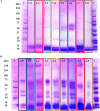Engineered nanoparticles bind elapid snake venom toxins and inhibit venom-induced dermonecrosis
- PMID: 30286075
- PMCID: PMC6171825
- DOI: 10.1371/journal.pntd.0006736
Engineered nanoparticles bind elapid snake venom toxins and inhibit venom-induced dermonecrosis
Abstract
Envenomings by snakebites constitute a serious and challenging global health issue. The mainstay in the therapy of snakebite envenomings is the parenteral administration of animal-derived antivenoms. Significantly, antivenoms are only partially effective in the control of local tissue damage. A novel approach to mitigate the progression of local tissue damage that could complement the antivenom therapy of envenomings is proposed. We describe an abiotic hydrogel nanoparticle engineered to bind to and modulate the activity of a diverse array of PLA2 and 3FTX isoforms found in Elapidae snake venoms. These two families of protein toxins share features that are associated with their common (membrane) targets, allowing for nanoparticle sequestration by a mechanism that differs from immunological (epitope) selection. The nanoparticles are non-toxic in mice and inhibit dose-dependently the dermonecrotic activity of Naja nigricollis venom.
Conflict of interest statement
The authors declare that no competing interests exist.
Figures






Similar articles
-
Proteomic characteristics of six snake venoms from the Viperidae and Elapidae families in China and their relation to local tissue necrosis.Toxicon. 2023 Nov;235:107317. doi: 10.1016/j.toxicon.2023.107317. Epub 2023 Oct 14. Toxicon. 2023. PMID: 37839739
-
Proteomics and histological assessment of an organotypic model of human skin following exposure to Naja nigricollis venom.Toxicon. 2022 Dec;220:106955. doi: 10.1016/j.toxicon.2022.106955. Epub 2022 Oct 27. Toxicon. 2022. PMID: 36309071
-
Integrative characterization of the venom of the coral snake Micrurus dumerilii (Elapidae) from Colombia: Proteome, toxicity, and cross-neutralization by antivenom.J Proteomics. 2016 Mar 16;136:262-73. doi: 10.1016/j.jprot.2016.02.006. Epub 2016 Feb 12. J Proteomics. 2016. PMID: 26883873
-
Polyvalent Snake Antivenoms: Production Strategy and Their Therapeutic Benefits.Toxins (Basel). 2023 Aug 24;15(9):517. doi: 10.3390/toxins15090517. Toxins (Basel). 2023. PMID: 37755943 Free PMC article. Review.
-
Revealing the key organelle in the pathophysiology and clinical applications of animal toxins: Mitochondria.Toxicon. 2025 Apr;258:108323. doi: 10.1016/j.toxicon.2025.108323. Epub 2025 Mar 18. Toxicon. 2025. PMID: 40113182 Review.
Cited by
-
The Influence of Silver Nanoparticles Against Toxic Effects of Philodryas olfersii Venom.Int J Nanomedicine. 2021 May 25;16:3555-3564. doi: 10.2147/IJN.S293366. eCollection 2021. Int J Nanomedicine. 2021. PMID: 34079248 Free PMC article.
-
Green Hydrogel Synthesis: Emphasis on Proteomics and Polymer Particle-Protein Interaction.Polymers (Basel). 2022 Nov 6;14(21):4755. doi: 10.3390/polym14214755. Polymers (Basel). 2022. PMID: 36365747 Free PMC article. Review.
-
Varespladib (LY315920) and Methyl Varespladib (LY333013) Abrogate or Delay Lethality Induced by Presynaptically Acting Neurotoxic Snake Venoms.Toxins (Basel). 2020 Feb 20;12(2):131. doi: 10.3390/toxins12020131. Toxins (Basel). 2020. PMID: 32093386 Free PMC article.
-
Synthetic hydrogel nanoparticles for sepsis therapy.Nat Commun. 2021 Sep 21;12(1):5552. doi: 10.1038/s41467-021-25847-2. Nat Commun. 2021. PMID: 34548486 Free PMC article.
-
Pathogenesis of local necrosis induced by Naja atra venom: Assessment of the neutralization ability of Taiwanese freeze-dried neurotoxic antivenom in animal models.PLoS Negl Trop Dis. 2020 Feb 7;14(2):e0008054. doi: 10.1371/journal.pntd.0008054. eCollection 2020 Feb. PLoS Negl Trop Dis. 2020. PMID: 32032357 Free PMC article.
References
Publication types
MeSH terms
Substances
Grants and funding
LinkOut - more resources
Full Text Sources
Other Literature Sources
Medical

